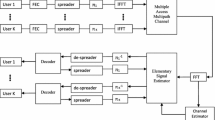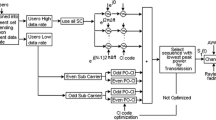Abstract
Multicarrier code division multiple access (MC-CDMA) is a novel wireless communication technology with high spectral efficiency and system performance. However, all multiple access techniques including MC-CDMA were most likely to have multiple access interference (MAI). So, this paper mainly aims at designing a suitable receiver for MC-CDMA system to mitigate such MAI. The classical receivers like maximal-ratio combining and minimum mean square error fail to cancel MAI when the MC-CDMA is subjected to nonlinear distortions, which may occur due to saturated power amplifiers or arbitrary channel conditions. Being highly nonlinear structures, the neural network (NN) receivers such as multilayer perceptron and radial basis function networks could be better alternative for such a case. The possibility NN receiver for a MC-CDMA system under different nonlinear conditions has been studied with respect to both performance and complexity analysis.








Similar content being viewed by others
References
Viterbi AJ (1995) CDMA: principles of spread spectrum communication. Addison-Wesley, Boston
Miller L, Lee J (1998) CDMA systems engineering handbook. Artech House, London
Weinstein SB, Ebert PM (1971) Data transmission by frequency-division multiplexing using the discrete Fourier transform. IEEE Trans Commun 19(5):628–634
Prasad R (2004) OFDM for wireless communications systems. Artech House, London
Prasad R, Hara S (1997) Overview of multicarrier CDMA. IEEE Commun Mag 35(12):126–133
McCormick AC, Al-Susa EA (2002) Multicarrier CDMA for future generation mobile communication. Electron Commun Eng J 14(2):52–60
Fettweis G, Bahai AS, Anvari K (1994) On multi-carrier code division multiple access (MC-CDMA) modem design. Proc IEEE Veh Technol Conf. doi:10.1109/VETEC.1994.345380
Hanzo L, Keller T (2006) OFDM and MC-CDMA: a primer. Wiley, West Sussex
Nathan Y, Jean-Paul MGL, Gerhard F (1994) Multi-carrier CDMA in Indoor Wireless Radio Networks. IEICE Trans Commun 77(7):900–904
Proakis JG (1995) Digital communications. Mc-Graw Hill, New York
Steele R, Hanzo L (1999) Mobile radio communications. Wiley, New York
Verdu S (1998) Multiuser detection. Cambridge University Press, Cambridge
Seyman MN, Taşpınar N (2013) Symbol detection using the differential evolution algorithm in MIMO-OFDM systems. Turk J Electr Eng Comput Sci 21:373–380
Silva A, Teodoro S, Dinis R, Gameiro A (2014) Iterative frequency-domain detection for IA-precoded MC-CDMA system. IEEE Trans Commun 62(4):1240–1248
Yan Y, Ma M (2015) Novel frequency-domain oversampling receiver for CP MC-CDMA systems. IEEE Commun Lett 19(4):661–664
Sung WL, Chang YK, Ueng FB, Shen YS (2015) A new SAGE-based receiver for MC-CDMA communication systems. Wirel Pers Commun 85(3):1617–1634
Hornik K (1991) Approximation capabilities of multilayer feedforward networks. Neural Netw 4(2):251–257
Seyman MN, Taspinar N (2013) Radial basis function neural networks for channel estimation in MIMO-OFDM systems. Arab J Sci Eng 38(8):2173–2178
Seyman MN, Taşpınar N (2013) Channel estimation based on neural network in space time block coded MIMO–OFDM system. Digit Signal Proc 23:275–280
Bagadi KP, Das S (2013) Efficient complex radial basis function model for multiuser detection in a space division multiple access/multiple-input multiple-output-orthogonal frequency division multiplexing system. IET Commun 7(13):1394–1404
Bagadi KP, Das S (2013) Neural network-based multiuser detection for SDMA–OFDM system over IEEE 802.11 n indoor wireless local area network channel models. Int J Electron 100(10):1332–1347
Bagadi KP, Das S (2013) Neural network-based adaptive multiuser detection schemes in SDMA–OFDM system for wireless application. Neural Comput Appl 23(3):1071–1082
Bagadi KP, Das S (2014) Multiuser detection in SDMA–OFDM wireless communication system using complex multilayer perceptron neural network. Wirel Pers Commun 77(1):21–39
Bagadi KP, Das S (2014) Minimum symbol error rate multiuser detection using an effective invasive weed optimization for MIMO/SDMA–OFDM system. Int J Commun Syst 27(12):3837–3854
Bagadi KP, Annepu V, Das S (2016) Recent trends in multiuser detection techniques for SDMA–OFDM communication system. Phys Commun 20:93–108
Taspnar N, Cicek M (2013) Neural network based receiver for multiuser detection in MC-CDMA systems. Wirel Pers Commun 68(2):463–472
Widrow B, Lehr MA (1990) 30 years of adaptive neural networks: perceptron, madaline, and backpropagation. Proc IEEE 78(9):1415–1442
Ko KB, Choi S, Kang C, Daesik H (2001) RBF multiuser detector with channel estimation capability in a synchronous MC-CDMA system. IEEE Trans Neural Netw 12(6):1536–1539
Schumacher L, Pedersen KI, Mogensen PE (2002) From antenna spacings to theoretical capacities-guidelines for simulating MIMO systems. In: The 13th IEEE international symposium on personal, indoor and mobile radio communications, pp 587–592
Patra JC, Meher PK, Goutam C (2009) Nonlinear channel equalization for wireless communication systems using Legendre neural networks. Signal Process 89:2251–2262
Author information
Authors and Affiliations
Corresponding author
Ethics declarations
Conflict of interest
We declare that this manuscript is original, has not been published before and is not currently being considered for publication elsewhere. So we have no conflict of interest.
Rights and permissions
About this article
Cite this article
C.V., R.K., Bagadi, K.P. Design of MC-CDMA receiver using radial basis function network to mitigate multiple access interference and nonlinear distortion. Neural Comput & Applic 31 (Suppl 2), 1263–1273 (2019). https://doi.org/10.1007/s00521-017-3127-0
Received:
Accepted:
Published:
Issue Date:
DOI: https://doi.org/10.1007/s00521-017-3127-0




